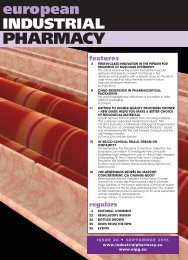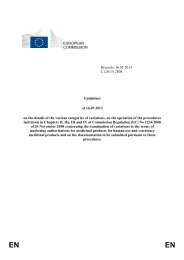PHARMACY
eip31-dec16
eip31-dec16
Create successful ePaper yourself
Turn your PDF publications into a flip-book with our unique Google optimized e-Paper software.
FORMULATION TECHNOLOGY CAN ENABLE ORAL DELIVERY OF NEW GENERATION MEDICINES<br />
continued<br />
Table 1: Delivery strategies to target drug liberation in the lower GI tract<br />
Technology approach<br />
Comment on trigger mechanism<br />
pH-trigger: polymers with Uses patient’s intestinal pH to dissolve coating polymer around dosage form to release drug. Acidic<br />
pH-dependent solubility functional group-substituted polymers that only dissolve above pH 6.0–6.5 (e.g. hydroxypropyl<br />
(enteric coated systems) methyl cellulose acetyl succinate, methacrylic acid copolymer). Can be applied to conventional<br />
tablet or capsule formulation of drug in conventional pan or fluid bed coater<br />
Time-dependent release Cellulosic or gum-based outer “shell” to conventional tablet dosage form containing the drug, can<br />
be applied by tablet-in-tablet compression equipment or could be applied in a coating pan.<br />
Provides for a 5–6 hour erosion time of the shell polymer before drug is released. With typical<br />
average gastric emptying times for non-disintegrating single unit systems, this should deliver the<br />
contained drug to the lower GI tract<br />
Colonic microflora-controlled Activated by enzymes secreted by colonic bacteria. These enzymes degrade the polymer coating<br />
around the dosage form and liberate the contained drug. The coatings can be natural<br />
polysaccharides (e.g. amylose, chitosan, pectin, alginate) or synthetic (e.g. azo-polymers)<br />
Osmotic pumps<br />
Usually considered as extended-release systems, but typically these systems exhibit a delay before<br />
drug release is initiated, which can be manipulated to begin the extended release delivery in the<br />
distal small intestine<br />
Pressure-controlled systems These usually function by having a thicker enteric coat (typically methacrylic acid copolymer) than<br />
used for pH-dependent delivery or other water-insoluble polymer coat that is disrupted externally<br />
due to peristaltic waves in the colon or internally due to the dosage form imbibing fluid and the<br />
consequent build-up of pressure rupturing the coating. Performance is dependent on controlling<br />
film thickness and its integrity (pits, fissures, other flaws)<br />
Hybrid approach – combine Can be pH-dependent plus microflora-controlled, pH-dependent plus time-dependent, or timetwo<br />
trigger mechanisms dependent plus microflora-controlled. These combine the advantages and disadvantages of the<br />
single trigger, but offer a back-up trigger should one not function properly in any given situation.<br />
mucus with beneficial outcomes on<br />
disease. Phosphatidylcholine is a<br />
slow wetting amphiphilic surfactant<br />
that, in a conventional immediaterelease<br />
oral formulation, may be<br />
liberated prior to reaching the<br />
target inflamed intestinal site,<br />
thereby reducing its effectiveness.<br />
An optimised formulation<br />
developed by Lipid Therapeutics,<br />
known as LT-02 and based on 94%<br />
soy lecithin concentrate, is<br />
presented as granules coated with<br />
methacrylic acid–methyl<br />
methacrylate copolymer 1:2<br />
(Eudragit S), providing for<br />
polymer dissolution and<br />
phosphatidylcholine release once<br />
the granules encounter an<br />
environment of pH 7.0 or greater,<br />
targeting the distal ileum 13,14 . In a<br />
Phase 2b trial in 156 patients having<br />
inadequate response to mesalazine,<br />
LT-02 added on to existing therapy<br />
showed statistically significant<br />
improvement in disease relative to<br />
placebo 14 . It appears the product<br />
may help with those patients<br />
already receiving approved doses of<br />
mesalazine who continue to<br />
experience flares of disease activity.<br />
Phase 3 trials have commenced in<br />
Europe and are planned to be<br />
initiated in the USA during 2016<br />
through licensees Dr Falk GmbH<br />
and Nestlé Health Science 15,16 . If<br />
trials are successful, the product<br />
could receive regulatory approvals<br />
in 2019 15 .<br />
Antisense oligonucleotides:<br />
alicaforsen, cobitolimod<br />
(DIMS0150) and mongersen<br />
Therapeutic antisense<br />
oligonucleotides (ASOs) are<br />
synthesised short lengths of DNA or<br />
RNA (typically 15–20 bases),<br />
chemically modified to improve<br />
Table 2: Challenges with oral lower GI tract targeting<br />
Physiological variable<br />
Challenge to delivery technology<br />
High variability of inter- and Varied gastric emptying time for dosage form will variably accelerate or delay time to trigger (pH,<br />
intra-subject gastric motility pressure, enzymatic-based systems) or for time-dependent triggered systems will result in<br />
premature (if retained too long in stomach) or failure of delivery (if time for complete transit through<br />
GI tract is short)<br />
High variability in intra- and Can result in variable premature or failure of trigger for pH-dependent systems<br />
inter-subject GI pHs<br />
Low water, viscous liquid May challenge performance of systems requiring good water environment for trigger activation,<br />
colonic environment<br />
e.g. erosion-based time-dependent trigger systems<br />
Impact of disease state May modify GI pH and motility with dosage form performance risks as outlined above. May alter<br />
(e.g. degree of inflammation) colonic microflora, which may affect systems triggered by colonic bacterial enzymes<br />
Co-therapies<br />
IBD patients may also be treated with antacids, proton pump inhibitors or H2-antagonists which will<br />
impact the performance of pH-dependent systems leading to premature triggering and drug<br />
release. Patients also treated with probiotics might have an altered gut microflora which might<br />
impact the performance of systems triggered by the action of enzymes secreted by gut bacteria<br />
6 european INDUSTRIAL <strong>PHARMACY</strong> December 2016 • Issue 31





